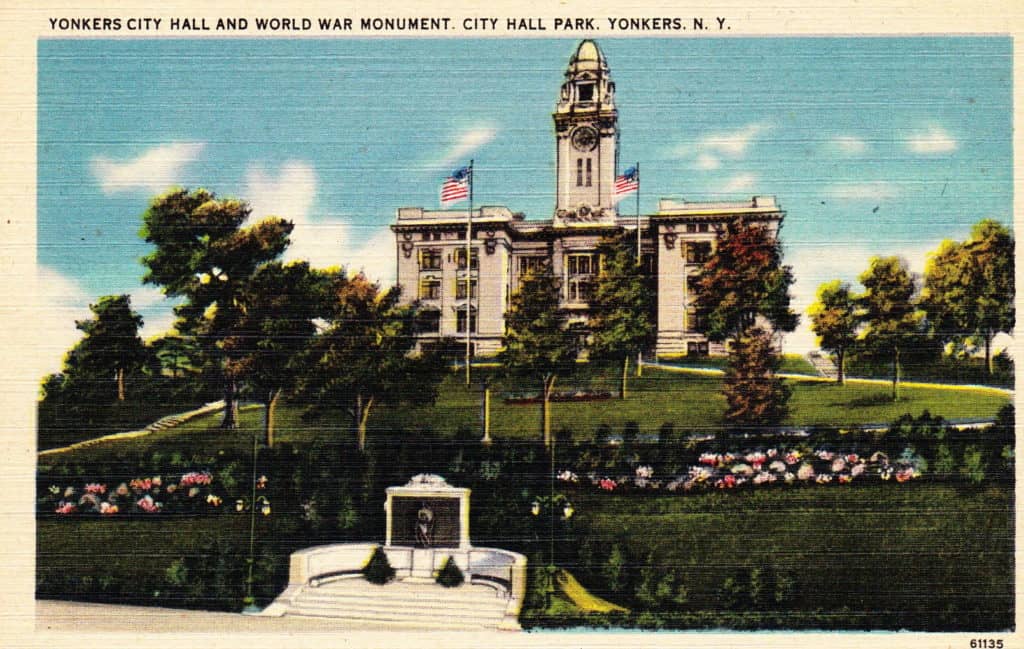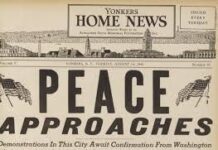
An old postcard of Yonkers City Hall and the War Memorial, prior to WWII
By Mary Hoar, President Emerita Yonkers Historical Society, recipient of the 2004 Key to History and President Untermyer Performing Arts Council
Monday, June 27th
June 27, 1911: Yonkers welcomed more than fifty survivors of the famous Mozart Regiment; fifty years earlier they mustered into service in Yonkers to fight the Civil War. Their barracks were a large brick flourmill and a machine shop on the waterfront; their encampment was in a large field called Camp Wood on Vineyard Avenue near High Street. Two Mozart Regiment members were awarded Medals of Honor, Sergeant Robert Boody and Private Henry Klein.
June 27, 1932: Two proud young boys delivered a 30-inch alligator to Parkway Police headquarters! They had seen it lurking under the bushes at Crestwood Lake near the Bronx River Parkway, so the youngsters captured and killed it for delivery.
Tuesday, June 28th
June 28, 1927: The Yonkers All Stars, a newly formed semi-pro baseball club under the management of Walter Donohue, played their premier game at Pelton Oval against the Brooklyn Royal Giants. Team members were Tex Greening, Frank Debroske, Boss Landy, Bill Ungvarsky, Lou Becker, Lefty Brooks and Cy Barker. Pitcher was Harry Beamish; catcher Pete Ormond completed the line up. Umpire was Bill Grieve.
June 28, 1933: Part of President Roosevelt’s recovery program went into effect in Yonkers; first class mail postage rate for a letter mailed locally, normally three cents, was reduced to two-cents. This reduction affected all areas of Yonkers except Nepera Park; that area had its own local post office and its own postmaster.
Wednesday, June 29th
June 29, 1914: New York Giants’ star pitcher Christy Mathewson visited Leake and Watts Orphan Home. After speaking to the boys, he gave an impromptu training on how to throw a baseball.
June 29, 1916: Habirshaw Cable and Wire Company filed plans to build a $150,000 building on the Hudson River waterfront.
Thursday June 30th
June 30, 1927: Yonkers’ Gold Star Mothers announced total opposition to the plan to move the World War Monument away from Washington Park to what became Larkin Plaza. The sculptor put a stop to the plan when he said it was not created to be a stand alone memorial, but was designed to be embedded into the hill. In other words, the back of the piece was not attractive.
June 30, 1944: Private Alfred J. Cerone was selected as “Guard of the Week” by Captain Robert Harmon, Provost at Columbia Army Air Base, SC. Cerone was selected for appearance, courteousness and performance of duty as a guard at the Post Exchange and base theaters.
Friday, July 1st
July 1, 1913: Reginald G. Whittemore and Company of Wall Street retired from the investment business. Whittemore, who lived on Arden Place, had accepted the presidency of the Automatic Calculator Company. He and other Wall Street players organized the company to sell the Sloan payroll and other “efficiency machines.” Former Senator George Agnew was treasurer and R. Hoyt Sloan secretary of the company.
July 1, 1944: Riverdale Avenue resident and NY Central Railroad employee, Private First Class Thomas Ryan was wounded in action in France. Ryan sent a letter to his sister Catherine announcing he “met with a little accident.” Then a telegram from the War Department arrived a few days later, informing Catherine her brother had a serious chest injury. Ryan’s next letter told his sister he was “feeling fine,” and was “up and about” at the base Hospital in England; Catherine’s next letter from the War Department assured her his progress was normal. Ryan’s Purple Heart was sent to his sister.
Saturday, July 2nd
July 2, 1907: Lockwood Avenue was abuzz with the discovery of children with dynamite. While playing in the woods, the children found the explosives in an unlocked powder magazine at the corner of Gordon and Roosevelt streets in Palmer Heights. The children opened it and took ten sticks of dynamite to bring home. Police returned the dynamite to William Folkes, Superintendent of the Heights. He promptly locked it up in the storehouse owned by the company laying out the new streets.
July 2, 1942: Taking the first step towards establishing wartime industry for arming, degaussing and repairing merchants’ ships, the Common Council cut $61,300 from the assessed valuation of the Yerks Dock on the Hudson. Briggs Avenue’s
Arthur Blair, Blair Shipyard, held two master contracts with the Federal government for ship work and anticipated employing 1200 men. The shipyard also would utilize the Yonkers Recreation Pier for their important work.
Sunday, July 3rd
July 3, 1911: The Ringling Brothers Circus came to Yonkers! More than 15,000 people enjoyed the greatest of all circuses, making Yonkers one of Ringling’s most profitable stops that year. It arrived with “peoples of a hundred nations and tribes,” a “large menagerie displayed in open dens,” and an “endless panorama of world wonders “ that “unfolded before the eyes.” Unfortunately, the heat was too much for several of the animals, and several horses were left at the crematory. Two local teenagers disappeared with the circus. One was found with the circus at the next stop in Poughkeepsie, but the second was not located.
July 3, 1949: Hero sea Captain George Fried passed away at his home in Yonkers. During his life, Fried was awarded several hundred medals and awards in recognition of his heroism. Two of his most notable and daring rescues at sea were of the Italian freighter Florida during a storm off the Virginia Capes while Captain of the SS America, and, while Captain of the SS Roosevelt, saving the crew of the British freighter Antinoe in a North Atlantic storm.
Questions or comments? Email YonkersHistory1646@gmail.com.
For information on the Yonkers Historical Society, Sherwood House and upcoming events, please visit our website www.yonkershistoricalsociety.org, call 914-961-8940 or email yhsociety@aol.com.





